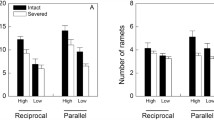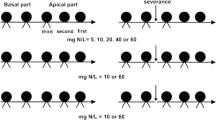Summary
Fragaria chiloensis is a stoloniferous perennial herb that grows on coastal sand dunes where scattered shrubs create small patches of lower photon flux density (PFD) but higher soil nitrogen availability. The potential effects of resource transport between ramets when PFD and soil nitrogen are negatively associated in space were tested by comparing the growth of pairs of ramets in which the vascular connection between ramets was either severed or left intact. One ramet in each pair was given high PFD but a low level of soil nitrogen and the other ramet was given low PFD but high N. The analogous effects of resource transport likely to be realized in nature were tested by substituting a more realistic medium soil nitrogen level in place of the high level. Results suggested that connected ramets exchanged carbon and nitrogen under both regimes of soil nitrogen heterogeneity. In the low versus high nitrogen regime, connected ramets had higher combined dry biomass and different patterns of dry mass partitioning from those of severed ramets; effect of connection was greater on ramets given low PFD and high N and on younger ramets. In the low versus medium nitrogen regime, connected ramets had different patterns of partitioning only. Apparent reciprocal resource transport between ramets can enhance the growth of ramets with complementary resource deficiencies, but may affect growth in dry mass only when maximum resource levels are high.
Similar content being viewed by others
References
Alpert, P (1990) Nitrogen-sharing among ramets increases growth in Fragaria chiloensis. Ecology (in press)
Alpert P, Mooney HA (1986) Resource sharing among ramets in the clonal herb, Fragaria chiloensis. Oecologia 70:227–233
Bloom AJ, Chapin FS, III, Mooney HA (1985) Resource limitation in plants — an economic analogy. Ann Rev Ecol Syst 16:363–392
Crick JC, Grime JP (1987) Morphological plasticity and mineral nutrient capture in two herbaceous species of contrasted ecology. New Phytol 107:403–414
Evans JP (1988) Nitrogen translocation in a clonal dune perennial, Hydrocotyle bonariensis. Oecologia 77:64–68
Gadgil RL (1971) The nutritional role of Lupinus arboreus-D in coastal sand dune fertility, Part 1. The potential influence of undamaged lupin-D plants on nitrogen uptake by Pinus radiata-G. Plant and Soil 34:357–367
Gutierrez JR, Whitford WG (1987) Chihuahuan Desert annuals: importance of water and nitrogen. Ecology 68:2032–2045
Hartnett DC, Bazzaz FA (1983) Physiological integration among intraclonal ramets in Solidago canadensis. Ecology 64:779–788
Jonsdottir IS, Callaghan TV (1988) The interrelationships between different generations of interconnected tillers of Carex bigelowii. Oikos 52:120–128
Jonsdottir IS, Callaghan TV (1989) Localized defoliation stress and the movement of 14C-photoassimilates between tillers of Carex bigelowii. Oikos 54:211–219
Kachi N, Hirose T (1983) Limiting nutrients for plant growth in coastal sand dune soils. J Ecol 71:937–945
Lau RR, Young DR (1988) Influence of physiological integration on survivorship and water relations in a clonal herb. Ecology 69:215–219
Nobel JC, Marshall C (1983) The population biology of plants with clonal growth. II. The nutrient strategy and modular physiology of Carex arenaria. J Ecol 71:865–878
Onyekwelu SSC (1972) The vegetation of dune slacks at Newborough Warren. I. Ordination of the vegetation. J Ecol 60:887–898
Pitelka LF, Ashmun JW (1985) In: Jackson J, Buss LC, Cook RE (eds) The population biology and evolution of clonal organisms. Yale University Press, New Haven, pp 399–345
Raphael DO, Nobel PS (1986) Growth and survivorship of ramets and seedlings of Agave deserti: influences of parent-ramet connections. Bot Gaz 147:78–83
Salzman AG, Parker MA (1985) Neighbors ameliorate local salinity stress for a rhizomatous plant in a heterogeneous environment. Oecologia 65:273–277
Schlesinger WH, Reynolds JF, Cunningham GL, Huenneke LF, Jarrell WM, Virginia RA, Whitford WG (1990) Biological feedbacks in global desertification. Science 247:1043–1048
Slade AJ, Hutchings MJ (1987a) The effects of nutrient availability on foraging in the clonal herb Glechoma hederacea. J Ecol 75:95–112
Slade AJ, Hutchings MJ (1987b) The effects of light intensity on foraging in the clonal herb Glechoma hederacea. J Ecol 75:639–650
Sokal RR, Rohlf FJ (1981) Biometry, second edition. Freeman, San Francisco
Tissue DT, Nobel PS (1990) Carbon relations of flowering in a semelparous clonal desert perennial. Ecology 71:273–281
Author information
Authors and Affiliations
Rights and permissions
About this article
Cite this article
Friedman, D., Alpert, P. Reciprocal transport between ramets increases growth of Fragaria chiloensis when light and nitrogen occur in separate patches but only if patches are rich. Oecologia 86, 76–80 (1991). https://doi.org/10.1007/BF00317392
Received:
Accepted:
Issue Date:
DOI: https://doi.org/10.1007/BF00317392




